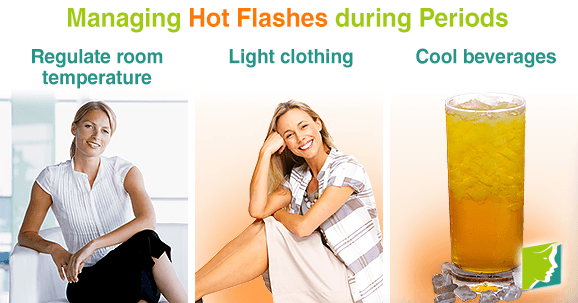Often, women associate hot flashes with the loss of the menstrual cycle during menopause, not regular periods during her reproductive life. Yet, a woman who is not menopausal can experience hot flashes during her menstrual cycle, especially if she is approaching menopausal age.
About Hot Flashes during Periods
Hot flashes affect as many as 70% of perimenopausal women (usually between ages 40 and 50) in the United States. During this time, the body is preparing for the end of menstruation, and a woman can experience menopausal symptoms anywhere between two and ten years before she actually reaches menopause. Women who have hot flashes during their menstrual cycle may experience a sudden burst of intense heat that radiates through the body from as short as 30 seconds to as long as five minutes.
Women who have hot flashes during their menstrual cycle usually experience them as part of premenstrual syndrome (PMS). PMS usually occurs in the days leading up to when a woman gets her period, and can have several symptoms, including hot flashes. These symptoms are related to the changes in hormone levels that trigger menstruation. Women who experience hot flashes have reported the following symptoms:
- Feeling overheated
- Sweating profusely
- Feeling nauseated
- Experiencing an increased heart rate
- Flushed or red in the face, neck, and chest
- Feeling anxious
These symptoms of hot flashes can usually be managed by incorporating a few key changes to one's daily routine.
Managing Hot Flashes during Periods
These are some good options to prevent hot flashes from occurring or manage hot flashes once they come on.
Regulate room temperature
Opening a few windows, turning on a fan, or cranking up the air conditioner are a few ways women can help lessen the frequency and intensity of their hot flashes during periods. A cool breeze helps maintain optimal body temperature and can help alleviate the symptoms of hot flashes if they occur.
Light clothing
Wearing lightweight and breathable clothing made of natural materials like cotton and linen can also help women feel cool throughout the day.
Cool beverages
While everyone enjoys a refreshing beverage from time to time, women who experience hot flashes have one extra reason to keep that glass of lemonade handy. Keeping the body hydrated with cool drinks, especially water, can help reduce the frequency and intensity of hot flashes.
Breathing exercises
When a hot flash starts, you can try breathing deeply and slowly to try to control it. This paced breathing should be abdominal, and you should breathe in through your nose and out through your mouth.
More Information on Hot Flashes during Periods
Women who experience hot flashes have a multitude of treatment options, including lifestyle adjustments, natural treatments, and prescription and nonprescription medicine. This link can help you find the most popular hot flashes treatments.
Sources
- Better Health Channel. (2015). Premenstrual Syndrome (PMS). Retrieved from http://www.betterhealth.vic.gov.au/bhcv2/bhcarticles.nsf/pages/premenstrual_syndrome
- Mayo Clinic Staff. (2014). Premenstrual Syndrome (PMS). Retrieved from http://www.mayoclinic.org/diseases-conditions/premenstrual-syndrome/basics/causes/con-20020003
- The North American Menopause Society. (2014). Treating Hot flashes. Retrieved from http://www.menopause.org/docs/for-women/mnflashes.pdf




